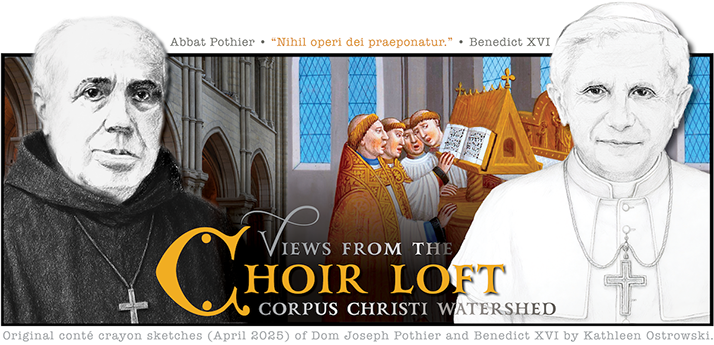 O MICROPHONE can accurately capture the complex, luscious, magnificent sound of a full choir in real life. Each singer aims for each pitch, but some are slightly higher and others slightly lower—and that’s what makes the choral sound so rich. People often complain: “Catholic priests won’t pay a living wage for choir directors, yet gladly pay millions to purchase a pipe organ.” That is certainly true (and scandalous), but I believe this is because most priests have never heard a full choir in real life. At this year’s Sacred Music Symposium, I will discuss techniques for recruiting (and keeping) volunteer singers.
O MICROPHONE can accurately capture the complex, luscious, magnificent sound of a full choir in real life. Each singer aims for each pitch, but some are slightly higher and others slightly lower—and that’s what makes the choral sound so rich. People often complain: “Catholic priests won’t pay a living wage for choir directors, yet gladly pay millions to purchase a pipe organ.” That is certainly true (and scandalous), but I believe this is because most priests have never heard a full choir in real life. At this year’s Sacred Music Symposium, I will discuss techniques for recruiting (and keeping) volunteer singers.
Quartet Vs. Choir • Professional groups—in an effort to save money—sometimes attempt polyphony with “one per part.” No matter how excellent the singers, this still produces a QUARTET SOUND, which is not the same as a choir. Indeed, the masterpieces of the Renaissance often juxtapose the sound of the QUARTET against the full choir, e.g. during the BENEDICTUS movement of the SANCTUS. Roger Wagner said: “Soloists are dangerous in any church choir! Their voices frequently do not blend with those of the other singers to form a rich, integrated tone.” The spectacular book by the legendary Dr. Stevenson provides irrefutable evidence showing that choirs were often quite large in Renaissance times. That makes sense, considering the massive churches their voices had to fill.
Rehearsal Videos • I often produce practice videos for each individual voice. Although these videos are far from perfect, they save rehearsal time. That means more time can be spent on vocal production, vowels, pronunciation, phrasing, and a million other things.
Part 1 (with me attempting Soprano):
![]()
Part 2 and Part 3 (with a real Soprano):
![]()
Sadness • You can download the PDF score (for free) and hear the rehearsal videos for each individual voice at #43065. However, most readers will not do that, and this makes me sad.

By the way, here’s an excerpt from the Stevenson book vis-à-vis how the members of the Sistine Chapel were chosen in the days of Father Cristóbal de Morales (d. 1553):
“When a new singer is proposed, his character shall first be examined, and then he shall be brought to a musical examination conducted by the choir members themselves. The first requisite is his voice quality; the second, his ability to keep his part in homophony; the third, his sufficiency as a singer of contrapuntal music; the fourth, his ability to sing plainsong; and the fifth his sight-reading ability. A secret vote shall be taken after his musical examination, and no singer may be admitted unless two-thirds of the singers (plus one vote) for his admission. After being admitted—and having attended to all the financial formalities—he must give himself solely to the daily routine in the pope’s chapel and may not sing elsewhere nor carry on other business. His duties as a new singer include moving the heavy choirbooks into place; as soon as a newer singer enters he no longer moves them into place for everyday singing, but he still carries them with his junior novice in the choir during processions. Absolute silence during divine office is required. All business such as requests for leaves of absence must be directed to the most senior member of the choir present. Special requests must be approved in a secret vote by two-thirds plus one. Heavy fines are to be assessed for malingering or other false reports. Every five years an extended leave is granted-five months for Italians; ten for French and Spanish. The feast box from the pope’s kitchen is to be awarded in rotation to choristers, who should divide it among their colleagues.”
![]()

